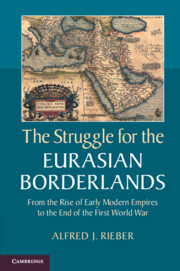 The Struggle for the Eurasian Borderlands
The Struggle for the Eurasian Borderlands Published online by Cambridge University Press: 05 June 2014
The rise and expansion of the multicultural conquest states changed one important feature of the Eurasian frontiers and inaugurated an era of struggle over the Eurasian borderlands. The frontier became less a zone of encounter between nomadic and sedentary societies and more a zone of encounters between organized state systems based on agricultural communities and urban centers, ruled (mainly) by hereditary monarchs or emperors wielding great, if not always absolute, power legitimized by various political theologies; they were governed with the assistance of civil and military elites drawn up in hierarchical orders and occupying the central institutions of the state. These frontier encounters also involved the indigenous populations that inhabited the contested territories. New types of frontier communities sprang up, some organized by the central state, others resisting that authority. Different sections of the Eurasian frontiers began to take on distinctive geocultural profiles. Henceforth in this narrative these sections will be called complex frontiers; complexity in this case signifying the number of state systems and social groups engaged in violent and peaceful intercourse within a broadly conceived geographical space that set restraints and opened possibilities for human action. On this basis, seven complex frontiers will serve as the matrix for this chapter: the Baltic littoral, the western Balkans (Triplex Confinium), Danubian frontier, Pontic steppe, Caucasian isthmus, Trans Caspia, and Inner Asia. As frontiers they cannot be sharply delimited; they are blurred and porous at the margins. Encounters in one section often spilled over into others. As the conquest states carved out territories within these frontiers, annexed and incorporated them, these borderlands did not cease to become sites of external and internal conflicts.
To save this book to your Kindle, first ensure no-reply@cambridge.org is added to your Approved Personal Document E-mail List under your Personal Document Settings on the Manage Your Content and Devices page of your Amazon account. Then enter the ‘name’ part of your Kindle email address below. Find out more about saving to your Kindle.
Note you can select to save to either the @free.kindle.com or @kindle.com variations. ‘@free.kindle.com’ emails are free but can only be saved to your device when it is connected to wi-fi. ‘@kindle.com’ emails can be delivered even when you are not connected to wi-fi, but note that service fees apply.
Find out more about the Kindle Personal Document Service.
To save content items to your account, please confirm that you agree to abide by our usage policies. If this is the first time you use this feature, you will be asked to authorise Cambridge Core to connect with your account. Find out more about saving content to Dropbox.
To save content items to your account, please confirm that you agree to abide by our usage policies. If this is the first time you use this feature, you will be asked to authorise Cambridge Core to connect with your account. Find out more about saving content to Google Drive.